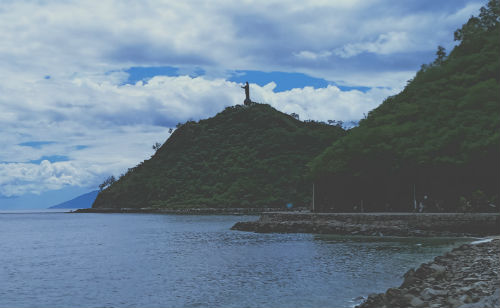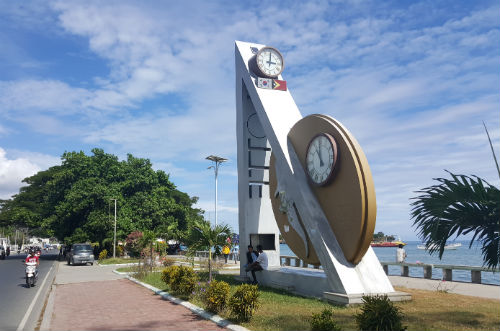The Chonnam Tribune provides an international student’s hometown story to promote mutual understanding between international and Korean students, and this issue has the story of an East Timorese student about his hometown. As of May, 18 East Timorese students from the National University of East Timor have become the second largest group of foreign exchange students studying at Chonnam National University. – Ed.
East Timor, also known as Timor-Leste, ranks number 156 in the list of countries by population. It is a former Portuguese colony that declared itself independent from Portugal on November 28, 1975. Nine days later, Indonesian forces invaded and occupied the former colony, with the tacit approval of the United States and Australia. By July 1976 the colony had been annexed as the province of Timor Timur. On May 20, 2002, Timor-Leste was internationally recognized as an independent nation under the official name of the Democratic Republic of Timor-Leste. I hope that this article will be helpful for Korean and foreign students from overseas to understand the culture and food of my country and hometown.

Social and Traditional Life
In East Timor, Iliomar is located in the south of Lautem District and is located on the other side of Lospalos. It is known for a lot of coconuts and animals such as chickens, goats, cows, buffalos, pigs and horses, and it also has so many mountains. The population is around 29 thousand of which 30% of them were moved to East Timor’s capital, Dili, to work or study with their family. Social life in this small town is different from those of other regions. Visitors and people who live around this town envy the way Iliomar people make relationships. Their social life which came from many ways to connect with other people has already been implemented by older generations and inherited till now. The eldest people create many cultural ceremonies including Oru-Oru (a collecting ceremony) and Ema Mate (a death ceremony).
Among those ceremonies, Fetosaa no Umane (a wedding bride and groom ceremony) in my town is indeed different from others around the country. When two families meet to know one another, a groom’s family should be prepared to welcome the bride’s family with pleasure to know each other as one family. After the meeting, someone from the family of the bride makes a decision to establish the price of the bride, nevertheless not with the obligation to agree, but the family of the groom would answer or agree based on their capacity in their economic life. In addition, most Fetosaa no Umane in East Timor must be given after the meeting, but then again, in Iliomar, it would be contradictory not to pay or give directly what the bride’s family ask for such as money or any resource that the groom’s family has. Plus, to have a good connection between these two families then they make an alternative arrangement to pay or give money slowly, like 10-20% every year or the family of the groom saves it till one of the bride’s family (a man) gets married then they will have the responsibility of paying it.

Social Activities and Food
Iliomar is certainly far away from the capital, so the authorities and people in the town create several social activities such as religious and general activities related to sports, entertainment or some other competitive activities. The largest gathering of activities are religious ones because about 99% of Iliomar people are Catholic, furthermore the youth loves these activities.
East Timorese people usually eat food made of rice, corn and so on with every meal and even for parties or traditional ceremonies. However, Iliomar’s people eat a wide range of foods cooked with banana, cassava, potato, pumpkin, papaya, etc. With all those kinds of ingredients, they cook food in various ways. As they know how to cook they teach people in other regions around Iliomar. Some people might even choose to live in Iliomar to learn how to cook food. Atematu asa Rama is made with cassava leaves which are cut into really small pieces, cooked with rice, and then mixed with fried candlenuts. A little bit different to Kaila asa Rama because they are cooked the same way however Kaila asa Rama is made with papaya leaves which are cut it into very small pieces too. Kaila asa Rama can be cooked or not because raw papaya leaves are good for eating.
One may fry, another may cook in a traditional pot, and others may burn food ingredients to make Tukir, which is one of the foods that is cooked with bamboo and different kinds of meat such as pork, dog, or cow. People mix meat with rice and cassava leaves, and burn it till the food gets cooked. Tukir is usually cooked in traditional events, but in modern life people started to cook it by themselves and sell it at the market. Kolak is also one of the famous foods in Iliomar since the Indonesian Occupation, and it is usually cooked in a traditional pot but now in modern life, most people are using a metal pot to cook it. This food is made with cassava, papaya, pumpkin and coconut oil.

Must-visit Attraction in East Timor
Iliomar is one of the regions where there are a lot of mountains, so most people love hiking. Among the mountains, Naunil Mountain is the highest mountain located in the north of Iliomar. On the top of the mountain, we can clearly see the city of Iliomar and feel fresh air and the beautiful view of the mountain which is always surrounded by clouds. This mountain is a deserted place and has a fresh feeling of nature. The national road that is the link between the capital Dili and Iliomar passes by Naunill Mountain, so tourists who want to visit Iliomar will primarily see the view of Naunil Mountain.
In this small village, food and places are very attractive. Most people are very social and are humanists. They care about other people around them. No matter who they are, acquaintances or foreigners, they can be a family. That is their tradition and culture inherited from older generations.
By Jose Moniz Da Costa Nunes, Exchange Student, Dept. of Civil Engineering
Photos by Choi Chang-won, Professor, Department of Development Economics,
National University of East Timor: Universidade Nacional Timor Lorosa’e (UNTL)

